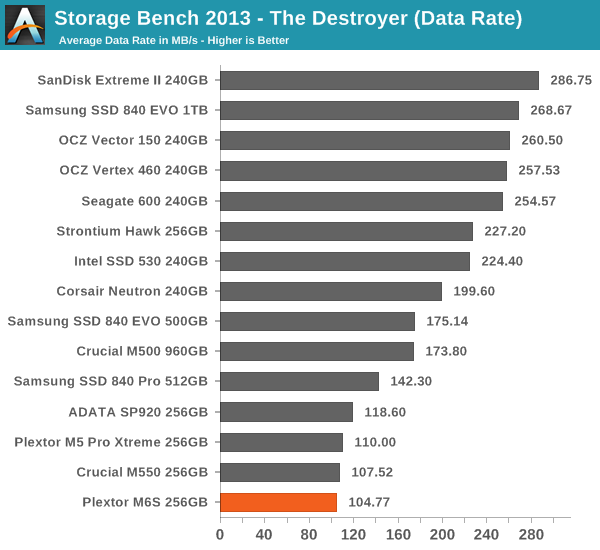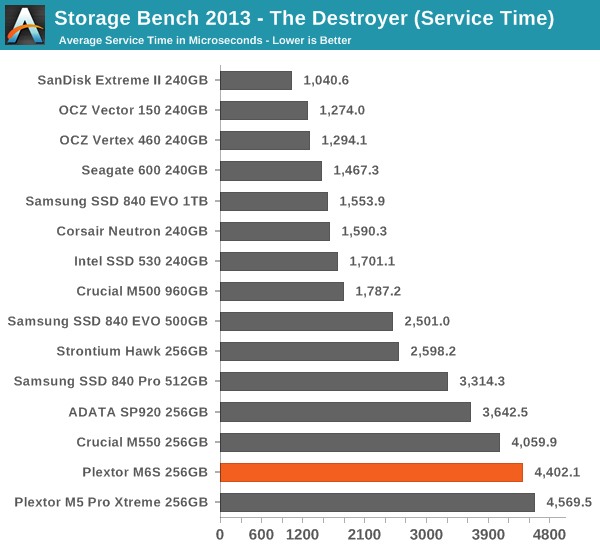Plextor M6S & M6M (256GB) Review
by Kristian Vättö on April 10, 2014 6:00 AM ESTAnandTech Storage Bench 2013
Our Storage Bench 2013 focuses on worst-case multitasking and IO consistency. Similar to our earlier Storage Benches, the test is still application trace based—we record all IO requests made to a test system and play them back on the drive we're testing and run statistical analysis on the drive's responses. There are 49.8 million IO operations in total with 1583.0GB of reads and 875.6GB of writes. I'm not including the full description of the test for better readability, so make sure to read our Storage Bench 2013 introduction for the full details.
| AnandTech Storage Bench 2013 - The Destroyer | ||
| Workload | Description | Applications Used |
| Photo Sync/Editing | Import images, edit, export | Adobe Photoshop CS6, Adobe Lightroom 4, Dropbox |
| Gaming | Download/install games, play games | Steam, Deus Ex, Skyrim, Starcraft 2, BioShock Infinite |
| Virtualization | Run/manage VM, use general apps inside VM | VirtualBox |
| General Productivity | Browse the web, manage local email, copy files, encrypt/decrypt files, backup system, download content, virus/malware scan | Chrome, IE10, Outlook, Windows 8, AxCrypt, uTorrent, AdAware |
| Video Playback | Copy and watch movies | Windows 8 |
| Application Development | Compile projects, check out code, download code samples | Visual Studio 2012 |
We are reporting two primary metrics with the Destroyer: average data rate in MB/s and average service time in microseconds. The former gives you an idea of the throughput of the drive during the time that it was running the test workload. This can be a very good indication of overall performance. What average data rate doesn't do a good job of is taking into account response time of very bursty (read: high queue depth) IO. By reporting average service time we heavily weigh latency for queued IOs. You'll note that this is a metric we've been reporting in our enterprise benchmarks for a while now. With the client tests maturing, the time was right for a little convergence.

The IO consistency already hinted that the M6S wouldn't perform very well in The Destoyer and that is indeed the case. The performance is slightly down from the M5 Pro Xtreme and is overall similar to the Crucial M550. Both of these drives have only 7% over-provisioning, which definitely hurts the benchmarks scores as there is unfortunately no way to test with added over-provisioning. It's hard to say how much the scores would improve with 12% over-provisioning but Toshiba (the Strontium Hawk is a rebranded Toshiba drive with a Marvell controller) is able to achieve more than twice the performance without any added over-provisioning, so there should certainly be room for improvement even without touching the over-provisioning.











30 Comments
View All Comments
Kristian Vättö - Friday, April 11, 2014 - link
Yes, there will be a review of the M6e. There has been some issues with testing and hence it's taking this long but it'll be my first priority as soon as we are able to overcome the issues.n3cw4rr10r - Thursday, April 10, 2014 - link
The prices for SSDs are still high imo. I am surprised they are still holding @ approx $1/gb in most cases.philipma1957 - Thursday, April 10, 2014 - link
samsung evo is far below $1 a gb and crucial M550's are far below $1 a gbssj3gohan - Thursday, April 10, 2014 - link
Finally actual proper idle power consumption results! It only took you a bit more than 5 years!HIPM and DIPM have been supported on all desktop systems - all desktop OSes as well as all hardware platforms - since the Athlon 64 X2 and first generation Core 2 (i945 chipset) times. I have been measuring SSD power consumption since they first came out - and yes, ever since the first SSDs, most of them supported the full gamut of power management - and have always been baffled that no review site on the internet has ever published accurate idle power consumption data. You are - aside from a few blogs I have come across - the first one. Congratulations!
Now, it's true that the first instances of especially DIPM were frought with latency issues and for a long time DIPM was turned off by default on Linux kernels (although Windows always forces it on in anything but the 'performance' power profile since Vista). Also, and this is probably the biggest issue, lots of BIOSes do not properly report SATA LPM or have it off by default. As it is usually fairly well hidden away it is not something many people think to turn on.
SATA ALPM is not at all a mobile feature. It has never been. Since support was baked in it has always been available to both laptop and desktop users. And with SSDs spending >>99% in idle, it represents easy and harmless power savings both in the SSD as well as the SATA I/O on the motherboard.
zodiacsoulmate - Thursday, April 10, 2014 - link
wow nice info!chubbypanda - Friday, April 11, 2014 - link
That's right. I always wondered why SSD reviewers at AnandTech claim it's mobile only. It's available at least on Denlow platform for sure.By the way, HIPM/DIPM feature itself is easy to control in Windows with simple registry update:
https://communities.intel.com/message/225489
Kristian Vättö - Friday, April 11, 2014 - link
"Also, and this is probably the biggest issue, lots of BIOSes do not properly report SATA LPM or have it off by default."That is the issue I had previously. The motherboard in my old testbed doesn't have the option to enable link power management and hence I couldn't perform those tests.
Ethos Evoss - Thursday, April 10, 2014 - link
Don't understand your tests ...It is all bollocks.. so few months back M5M was best and now it is on bottom ? that is all BULLCRAP
DanNeely - Thursday, April 10, 2014 - link
The M5M was reviewed a year ago. It's performance was underwhelming compared to sata drives then; but at the time getting an mSata drive at retail was much easier said than done; and at the time it was still a reasonable buy for its money. Since then much better mSata drives have came out and Plextor is trying to charge a premium device price while providing performance much worse than that of competing products that are significantly cheaper.http://anandtech.com/show/6722/plextor-m5m-256gb-m...
Ethos Evoss - Thursday, April 10, 2014 - link
Then M6M is NOT big step from M5M .. I have 2x M5M 256GB and they fliesI am not replacing then .. not worth ..